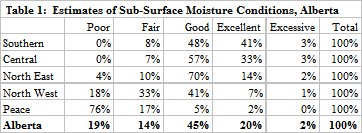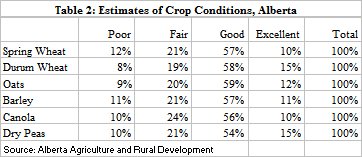| | Warm temperatures, coupled with rain showers, have provided favorable crop growing conditions for the last two weeks in the province. The exception is the southern and central areas of the Peace Region, where precipitation received during the last two weeks ranged from trace to less than 15 mm, and moisture conditions continue to deteriorate. For the rest of the province, precipitation is mostly 5-45 mm in the Central Region, and 10-70 mm in the Southern, North East and North West Regions. Overall, soil moisture reserves in the province are adequate, with the exception of the Peace Region. Table 1 below presents estimates of sub-surface moisture conditions for the province, by region.
The recent favorable weather conditions have advanced crop development. In the Central Region, canola and dry peas are generally podding, while spring cereals are in the late milk to early dough stage. However, due to delayed seeding and cool temperatures earlier this spring, crop development remains 10-20 days behind normal in the Southern Region, and 7-10 days behind normal in the Central, North East and North West Regions. Also, hailstorms have caused crop damage in some areas. Provincially, nearly 70 per cent of spring cereals and 66 per cent of canola are in good to excellent condition (see Table 2). About 80 per cent of winter cereals are rated as good to excellent, while specialty crops under irrigation, primarily in the Southern Region, range mostly from fair to good. Crop harvest has begun, mainly in the Southern Region for winter cereals/dry peas, and in the Peace Region for canola/dry peas. Crop yields are expected to be above average in the province, with the exception of the Peace Region, where yields are mostly below average.
Rain showers have delayed haying operations, resulting in some quality deterioration for hay in swath. The first cut is estimated at 85 per cent complete. Yields are below average in the Peace Region, but significantly above average in other areas of the province. Overall, hay quality varies, ranging from poor to excellent. As well, some producers have started the second cut. Due to the lack of moisture, 76 per cent of pasture in the Peace Region is still in poor condition. Provincially, pasture is rated as 16 per cent poor, 21 per cent fair, 46 per cent good, and 17 per cent excellent.
The damp weather conditions this summer have contributed to crop diseases in many areas. Also, some areas have reported problems with gophers, lygus bugs, flea beetles, grasshoppers, root maggots, and diamond back larvae/moths, with pesticides being applied.


Our thanks to Alberta Agricultural Fieldmen, staff of AFSC and the Alberta
Ag-Info Centre for their partnership and contribution to the Alberta Crop
Reporting Program.
Regional Assessments:
The 2010 Alberta Crop Report Series continues to provide summaries for the following five regions:
Region One: Southern (Strathmore, Lethbridge, Medicine Hat, Foremost)
- Weather conditions during the last two weeks have been mainly favorable, despite rain showers hindering haying operations. Soil moisture reserves are generally adequate, and even excessive in some fields. Hailstorms have caused crop damage in some areas. Also reported are leaf diseases, and spraying for lygus bugs.
- About 70 per cent of spring cereals and 65 per cent of canola are in good to excellent condition. Overall, crop development remains 10-20 days behind normal. Yield prospects for most major and specialty crops are above average. Crop harvest has begun, mainly for winter cereals and dry peas.
- Producers are wrapping up their first cut haying operations, with above average yields reported for both dryland and irrigation. Overall, hay quality ranges from fair to excellent. Pasture growth is generally rated as good to excellent.
Region Two: Central (Rimbey, Airdrie, Coronation, Oyen)
- Rain showers during the last two weeks have delayed haying operations, resulting in some quality deterioration for hay in swath. Hay yields from the first cut, estimated at 73 per cent complete, are above average, while quality ranges from poor to good. Excessive moisture is still a concern in some areas.
- About 75 per cent of spring cereals/canola, and 80 per cent of dry peas are in good to excellent condition. Yield prospects for major and specialty crops are significantly above average. Overall, crop development is mostly 7-10 days behind normal. Some producers have started making silage. There are localized hailstorms causing crop damage. Also, some areas have reported concerns with crop disease, and problems with gophers and other pests.
- The adequate moisture reserves have boosted pasture growth, which are mostly in good to excellent condition.
Region Three: North East (Smoky Lake, Vermilion, Camrose, Provost)
- Crops are generally in good to excellent condition, and yield potentials are significantly above average. Hailstorms have caused crop damage in some areas. Soil moisture reserves are adequate, and even excessive in some fields. Warm, dry weather is needed, as crop development remains 7-10 days behind normal. Also, some areas have reported concerns with crop diseases.
- Rain showers have hampered haying operations, and caused some quality deterioration for hay in swath. The first cut is estimated at 77 per cent complete, with yields markedly above average, and quality ranging from poor to good.
- Pasture condition is rated as two per cent poor, 18 per cent fair, 63 per cent good, and 17 per cent excellent.
Region Four: North West (Barrhead, Edmonton, Leduc, Drayton Valley, Athabasca)
- In most areas of the region, rain showers have delayed haying operations, and resulted in some quality deterioration for hay in swath. The first cut haying operation is estimated at 88 per cent complete. Hay yields are above average, while quality ranges from poor to good. Soil moisture reserves are mostly adequate.
- The majority of crops in the region are reported as good to excellent, with above average yield potentials. The recent warm temperatures have helped crops advance rapidly, but in many areas, crop development is still 7-10 days behind normal. Also, some areas have reported crop damage due to hailstorms, and there are concerns with crop diseases, and problems with gophers and other pests.
- Pasture is rated as seven per cent poor, 38 per cent fair, 48 per cent good, and seven per cent excellent
Region Five: Peace River (Fairview, Falher, Grande Prairie, Valleyview)
- Moisture and crop conditions continue to deteriorate in the southern and central areas of the region, where precipitation received during the last two weeks ranged from trace to less than 15 mm. Precipitation in most of the northern and southeastern parts ranged from 15-35 mm, with soil moisture reserves rated as poor to excellent.
- Overall, spring wheat is rated as 40 per cent poor, 38 per cent fair, 17 per cent good, and five per cent excellent, while canola is 34 per cent poor, 40 per cent fair, 20 per cent good, and six per cent excellent. Crop harvest has begun, mainly for dry peas and canola, with estimated yields below average. Some insecticide applications have occurred, to control lygus bugs, flea beetles, and diamond back larvae/moths.
- The first cut haying operation is virtually complete. Yields are estimated to be below average, while quality ranges from fair to excellent. Pasture growth is reported as 76 per cent poor, 17 per cent fair, three per cent good, and four per cent excellent.
Note to Users: The contents of this document may not be used or reproduced without properly accrediting Alberta Agriculture and Rural Development, Economics and Competitiveness Division, Statistics and Data Development Branch. |
|